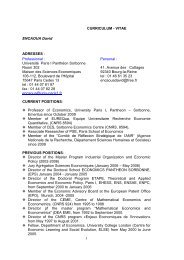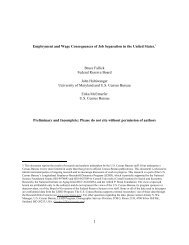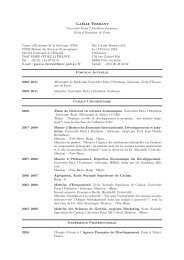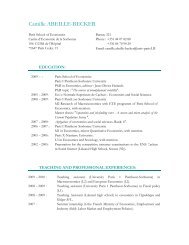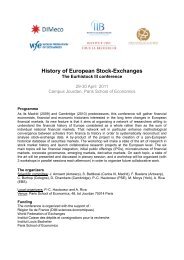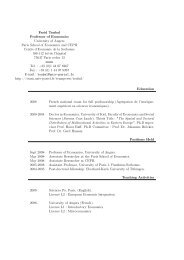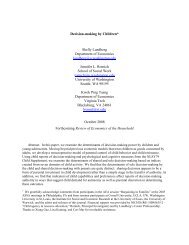info document - Paris School of Economics
info document - Paris School of Economics
info document - Paris School of Economics
Create successful ePaper yourself
Turn your PDF publications into a flip-book with our unique Google optimized e-Paper software.
τ(y). Putting these pieces together, the problem <strong>of</strong> a type j individual can be written as:maxc s,a s+1 ,i ss.tS∑β s−1 u(c s , n s )s=1c s + a s+1 = (1 − ¯τ n (y s ))y s + (1 + r)a sh s+1 = h s + A j (h s i s n s ) α (1)y s = P H h s (1 − i s )n s (2)Using the fact that Q j s = A (h s i s n s ) α , the “cost <strong>of</strong> investment” (ie., h s i s n s ) can be writtenas: C j (Q j s) = (Q s /A j ) (1/α) , which will play a key role in the optimality conditions below.Now, it is useful to distinguish between two cases.Inelastic Labor Supply. First, suppose that labor supply is inelastic, in which casen s = 1. The optimality condition for human capital investment is (assuming an interiorsolution):(1 − τ(y s )) C ′ j(Q j s) ={β(1 − τ(y s+1 )) + β 2 (1 − τ(y s+2 )) + ... + β S−s (1 − τ(y S ))}. (3)The left hand side is the marginal cost <strong>of</strong> investment, whereas the right hand side is themarginal benefit, which is given by the present discounted value <strong>of</strong> net wages in all futuredates earned by the extra unit <strong>of</strong> human capital. Notice that both the marginal cost andbenefit <strong>of</strong> investment take into account the marginal tax rate faced by the individual. Tounderstand the effect <strong>of</strong> taxes, first consider the case when taxes are flat-rate, ie, τ ′ (y) ≡ 0.In this case, all terms involving taxes cancel out and the FOC reduces to:C ′ j(Q j s) ={β + β 2 + ... + β S−s }.Thus, flat-taxes have no effect on human capital investment. This is a well-understoodinsight that goes back to at least Heckman (1976) and Boskin (1977).Now consider progressive taxes, ie., τ ′ (y) > 0. We rearrange equation (3) to get:C ′ j(Q j s) ={β1 − τ(y s+1)1 − τ(y s )} {{ }Progressivity wedge+ β 2 1 − τ(y s+2)1 − τ(y s )} {{ }...+ ... + β S−s 1 − τ(y S )1 − τ(y s )} {{ }}. (4)Progressivity wedge6




